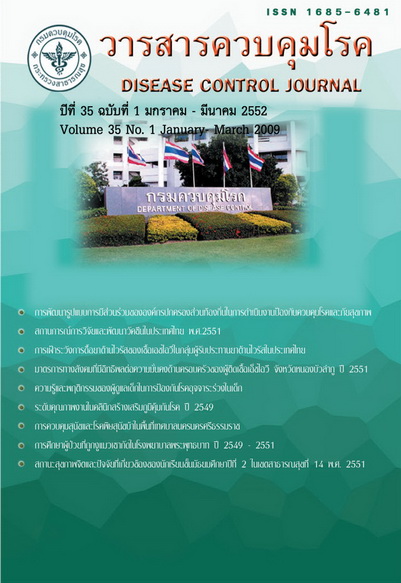Quality Assessment of Immunization Practice at Clinics in 2006
Keywords:
EPI, ImmunizationAbstract
The objective of this cross sectional survey was to assess the quality of immunization practice at immunization clinics of government hospitals and at health centers in Thailand. The study population were health officers who worked in immunization clinics. The number of provinces was randomly selected in proportion to the number of provinces in each of the 4 regions. The total of 25 provinces were finally selected. In each province, 2 clinics in hospitals (hos) and 2 clinics in health centers (hc) were chosen at random. The assessment was conducted by experienced personnel of the Bureau of General Communicable Diseases, by face-to-face interview on health officers conduct about vaccine management using questionnaire and by observation. The survey showed that most of the clinics, both in hospitals and health centers, met the standard for immunization clinic operation eg. provide regular monthly vaccination service, maintain standard cold chain equipments (refrigerator specific for vaccine, vaccine carriage, and ice peck),carry out service procedure with low risk for contamination. However, detail information which is essential for surveillance and investigation of Adverse Events Following Immunization : AEFIs is not available. For example, there was no record of vaccine lot number (at hos and at hc : 32% and 56% respectively),the thermometer was inaccurate (at hos and at hc : 27% and 19% respectively), cold chain temperature was out of recommended range (at hos and at hc : 19% and 21% respectively), There were expired vaccines kept in the refrigerator (at hos and at hc : 25% and 25% respectively). For registration and record of the vaccinees, the name list was available for children under 5 year old in most places (at hos and at hc : 96% and 100% respectively), but the list for vaccines was present at lower rate in antenatal clinic (at hos and at hc : 88% and 89% respectively) and school-based immunization (at hos and at hc : 49% and 60% respectively). To further improvement of the program, the immunization management training need to be strengthened with emphasis on detail and quality of work. Staff responsible for immunization at the provincial and district levels should provide close supervision, systematically and regularly, to increase the capacity of staff at service level.
Downloads
References
2. กลุ่มโรคติดต่อที่ป้องกันได้ด้วยวัคซีน สำนักโรคติดต่อทั่วไป กรมควบคุมโรค กระทรวงสาธารณสุข. คู่มือการสร้างเสริมภูมิคุ้มกันโรค พ.ศ. 2548. สำนักงานกิจการโรงพิมพ์ องค์การสงเคราะห์ทหารผ่านศึก, 2548.
3. กลุ่มโรคติดต่อที่ป้องกันได้ด้วยวัคซีน สำนักโรคติดต่อทั่วไป กรมควบคุมโรค กระทรวงสาธารณสุข. คู่มือการปฏิบัติงานการสร้างเสริมภูมิคุ้มกันโรคสำหรับเจ้าหน้าที่สาธารณสุข พ.ศ. 2547. กรุงเทพมหานคร : สำนักงานกิจการโรงพิมพ์ องค์การสงเคราะห์ทหารผ่านศึก, 2547.
4. สำนักโรคติดต่อทั่วไป กรมควบคุมโรค กระทรวงสาธารณสุข. คู่มือการบริหารจัดการวัคซีน และระบบลูกโซ่ความเย็น พ.ศ. 2547. กรุงเทพมหานคร : โรงพิมพ์การศาสนา สำนักงานพระพุทธศาสนาแห่งชาติ, 2547.
5. กลุ่มพัฒนาระบบและมาตรฐานงานระบาดวิทยา สำนักระบาดวิทยา กรมควบคุมโรค กระทรวงสาธารณสุข. คู่มือการเฝ้าระวังและสอบสวนอาการภายหลังได้รับการสร้างเสริมภูมิคุ้มกันโรค 2546. องค์การรับส่งสินค้าและพัสดุภัณฑ์, 2546.
6. กลุ่มโรคติดต่อที่ป้องกันได้ด้วยวัคซีน สำนักโรคติดต่อทั่วไป กรมควบคุมโรค กระทรวงสาธารณสุข. แผนปฏิบัติงานโรคติดต่อที่ป้องกันได้ด้วยวัคซีน ประจำปีงบประมาณ 2549. เอกสารอัดสำเนา.
7. กลุ่มโรคติดต่อที่ป้องกันได้ด้วยวัคซีน สำนักโรคติดต่อทั่วไป กรมควบคุมโรค กระทรวงสาธารณสุข. การสำรวจความครอบคลุมของการได้ รับวัคซีนในนักเรียนชั้นประถมศึกษาปีที่ 1 และชั้นประถมศึกษาปีที่ 6 พ.ศ. 2547. สำนักงานกิจการโรงพิมพ์องค์การสงเคราะห์ทหารผ่านศึก, 2548.
Downloads
Published
How to Cite
Issue
Section
License
Articles published in the Disease Control Journal are considered as academic work, research or analysis of the personal opinion of the authors, not the opinion of the Thailand Department of Disease Control or editorial team. The authors must be responsible for their articles.






